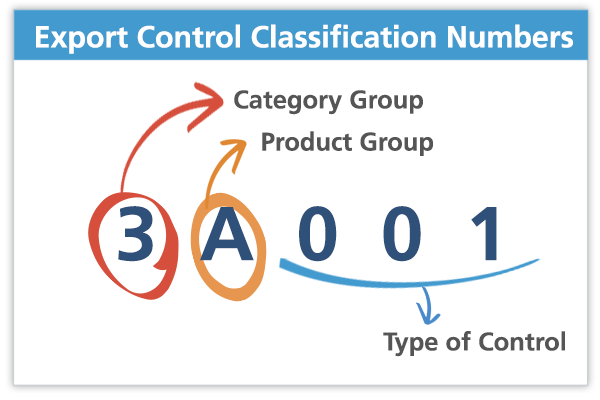Export compliance requires correctly assessing if the export product requires a U.S. Department of Commerce license.
This assessment determines whether the item has a distinct Export Control Classification Number (ECCN).
So, what is an ECCN number? ECCNs are unique five-digit alphanumeric codes detailed in the Commerce Control List (CCL). The CCL aims to help exporters identify any products that are subject to the Export Administration Regulations (EAR).
These numbers categorize export goods based on the product type, such as commodity, software, or technology. You can see the anatomy of an ECCN below:

ECCN is a classification system that sorts items according to their inherent characteristics, encompassing the product’s type, technology, software, and relevant technical attributes.
It’s essential to distinguish ECCNs from other designations, including Schedule B numbers which is employed by the U.S. Bureau of Census for trade statistics collection.
Once you’ve found the right ECCN for a product, you can research the specifics of licensing prerequisites, identify which transactions may necessitate an export license, and potential exemptions, if applicable. That’s why it’s crucial to answer the common question – how do I find my ECCN number?
Understanding the Commerce Control List
The Commerce Control List (CCL) is a comprehensive roster of items subject to regulation by the Bureau of Industry and Security (BIS). It’s crucial to thoroughly examine the CCL to determine an item’s ECCN, along with any specific requirements.
ECCN’s first number determines the broad category to which an item belongs, as defined in the CCL. Each category is further divided into five distinct product groups, reflected in the second character of the ECCN. The Commerce Control List assigns the remaining three digits, which are contingent upon the specific attributes and functionalities of the given item. See the full list of unofficial Export Administration Regulation files here.
Review the following tables to see how these numbers reflect different industries and attributes.
Commerce Control List Categories (First Number)
| Category Number | Category Description |
| 0 | Nuclear materials, facilities, and equipment (and miscellaneous items) |
| 1 | Materials, Chemicals, Microorganisms and Toxins |
| 2 | Materials Processing |
| 3 | Electronics |
| 4 | Computers |
| 5 | Telecommunications and Information Security |
| 6 | Sensors and Lasers |
| 7 | Navigation and Avionics |
| 8 | Marine |
| 9 | Propulsion Systems, Space Vehicles, and Related Equipment |
Product Groups (Second Number)
| Product Group Number | Product Group Description |
| 1 | Systems, Equipment, and Components |
| 2 | Test, Inspection, and Production Equipment |
| 3 | Material |
| 4 | Software |
| 5 | Technology |
How Do I Find My ECCN Number?
Identifying the ECCN for a commodity can be accomplished through three methods, and you may have to work with a few of them to determine the correct ECCN for your export.
1. Direct Inquiry
Reach out to the item’s manufacturer to check if they already have an up-to-date ECCN. Be aware that ECCNs may be updated or revised, so conducting thorough research and due diligence is essential to stay compliant with export regulations.
2. Self-Classification
It’s possible to self-classify the item if you have a strong technical grasp of the product and familiarity with the Commerce Control List (CCL) structure and format. You can accurately classify an item within the CCL by first determining its category within the control list and then pinpointing its specific product group.
Once you’ve determined these two attributes, you can compare the item’s functions and unique characteristics to the ECCNs outlined in the CCL.
3. Requesting an ECCN from the BIS Directly
Exporters can formally contact the Bureau of Industry and Security (BIS) to request a commodity classification if necessary. You must have a Company Identification Number (CIN) to access the online system.
It’s crucial to note that official requests to BIS can be time-consuming and typically cover up to six items. However, a case-by-case exemption is granted by BIS when items and goods are closely related.
What Does an EAR99 Designation Entail?
Most export goods don’t need an export license. A classification known as EAR99 allows exporters to bypass licensing and other potential requirements.
EAR99 is designated when an item does not fall within the parameters of an ECCN but still falls under the purview of the Export Administration Regulations (EAR) and is not under the control of another federal agency.
Under the EAR99 classification, no export license is required if the following conditions are met:
- The destination is not a sanctioned location.
- The item is not intended for shipment to a prohibited end-user, denied party, or sanctioned entity.
- The item will not be utilized for a specific end-use that may necessitate heightened regulatory controls.
It’s vital to do your due diligence to understand if an EAR99 is applicable or if there are additional licensing requirements to be aware of. Requesting clarification from BIS directly is worth the effort to avoid mislabeling an exported good.
How Can Descartes Visual Compliance Help?
Descartes has built the world’s leading tool for researching ECCNs and understanding classification criteria. Our solution helps you identify the most relevant classifications in the CCL for your products and determine if export licenses are required.
Schedule a demo today and see how our industry-leading Export Control Classification Number solution can help your operation.

